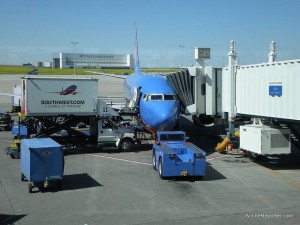
Don't blame the airline for when things happen out of their control!
Consumer advocate Chris Elliott recently wrote a blog stating, “Airlines should refund tickets for cancellation, death, disease and other unfortunate circumstances.” I very much respect Elliott’s work, but him being a consumer advocate and me being an airline advocate, we are going to disagree.
Elliott cites a survey where 88% of passengers said they should get a full refund if their next of kin dies, 80% said they should get a refund if they had a communicable disease and 33% said they should if they can’t make it to the airport for reasons beyond their control.
Now, don’t get me wrong, having any of these things happen to you bites (probably the death and disease thing bites more than being late). But how are any of these the fault of the airline? They aren’t.
Airlines give you a choice. Would you like to buy a refundable ticket for a higher price or a non-refundable for cheaper? It is a gamble. What are the chances someone close to you will pass away? That you will get really sick? Or a jack-knifed truck will make you miss your plane? If you think these and other reasons could make you miss your flight, then get the refundable ticket. If you like to take risk and want to save a few bucks, then get the refundable…easy enough. If you lose your gamble, so be it.
I have lost quite a bit of money to the airlines for deaths, illness, a hurricane and just changes of plans. Each one of those where bad situations, but I didn’t expect the airline to refund my money for issues out of their control. I was able to redeem at least some of my money on each ticket. Most airlines will give you credit for future travel with-in a year, for a fee ($25-$100 or so). I know I made the decision to get a non-refundable ticket, took the risk, and I win most times. Over all, it has been very beneficial getting non-refundable tickets over refundable.
There is also a bigger picture here. Airlines are not charities. They need to make a profit to exist and fly us all over the world. If they start offering refunds for incidents that are not their fault, that means all fares go up. Do you want to pay more for your ticket because someone can’t make it to the airport on time? No thanks!
In 2009 there were 711,000,000 passengers that flew in the US. How many of those do you think had a death in the family, got sick or missed their airplane? Even a very small percentage still means big money for airlines.
Now, this is not to say that if airlines mess up and it is their fault you don’t make your flight, you should get taken care of. However, there are already rules in place to protect you when it is the airline’s fault.
What do you think? Should airlines refund more tickets? Should there be a third option for life changing events?
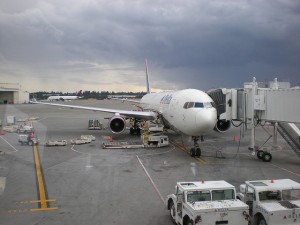
It is too dark and rainy to get a good photo of my plane today. But this is the Delta 767 that took me to Atlanta last year.
Back at Seattle-Tacoma International Airport. I was looking forward to seeing the new body scanners here, but there weren’t any in my security line…I am going to have to look into that.
I am on my way to Atlanta, GA to hang out with Delta Air Lines for the day. I am going to check out how they operate and talk to some folks to find out what their game plan is for the future.
Delta is currently the largest airline in the world. How does such a large airline manage 160 million passengers per year, 354 destinations in 65 countries, 75,000 employees and a fleet of more than 725 aircraft ranging from 34 passenger Saab 340B to the 403 passenger Boeing 747-400? I am not quite sure, but I am sure as heck excited to find out.
Today, I will be flying on a Boeing 767-300 and I have the privilege of testing out Delta’s domestic first class. This is great, since last year I flew on the exact same route in economy.
Do you have any questions for Delta you would like answered? Leave them in the comments or email me at da***@*************er.com and I will see what I can do.
UPDATE: I couldn’t see the reg number at the gate, but now know it is N136DL. Airliners.net has some pics of her in the old Delta livery.
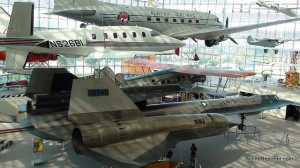
Alaska Airlines DC-3, Lear Fan 2100 hang from the ceiling, while an SR-71 and United Airlines Boeing 80A-1 hang out on the ground at the Museum of Flight
Over the past ten years I have (almost) consistently lived no farther than 30 miles away from the Museum of Flight (MoF) at Boeing Field in Seattle. However, I haven’t visited once in that last ten years. Being so close has been the problem. I have always thought, “well, I can go next weekend,” but I haven’t. I took such a wonderful aviation museum for granted and never went to re-discover what they have.
Well, I got sick and tired of hearing about all the cool new things they have and decided to go check them out myself. I was lucky to have Ted Huetter, Public Relations and Promotions Manager, show me around the place. Ted might work in PR, but there is no question he is an aviation nut and knows his stuff!
Last time I visited the MoF, they had a bunch of hanging airplanes (which don’t get me wrong are cool enough) and the old red Boeing barn. Today, not only do they have all that cool stuff still, but also their airpark, World War I and II displays and lots of nifty space stuff.
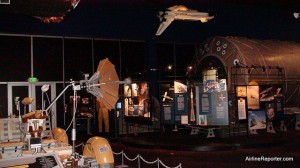
Lunar Rover on the left. Space station module on the right. Awesomeness all around.
The MoF started in 1964 when a small group of people set about wanting to maintain the history of aviation. The first aircraft obtained was displayed in the Seattle Center, where the Seattle Worlds Fair occurred in 1962. In 1975 the Port of Seattle leased the land the museum is currently on for 99 years (so better hurry before 2074). The Red Barn, which is the birthplace of The Boeing Company, was saved from demolition on its original location on the Duwamish River, and floated by river-barge to its current location.
The museum has a mission to “acquire and conserve a valuable collection of artifacts relating to air and space history and technology.” But they also want to ensure that the public can get access. This is a difficult mixture, since people are destructive. Not just the hooligans who literally cause damage, but just breathing and touching items or even air and sunlight can be very destructive over time. It is a hard balance of what aircraft to give patrons access to versus which ones must remain off-limits to keep them in tip-top condition over time.
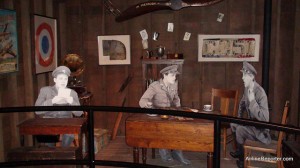
The Personal Courage Wing had much more than just airplanes. Really makes you feel like you travel back in time.
Even before I was able to make it into the lobby I was presented with eye candy outside. First they have a few aircraft on display, second you are right on Boeing Field, where the new test Boeing 787 Dreamliners and Boeing 747-8Fs are being housed, and lastly there were three Boeing 737-800 fuselages that were sitting on a train just outside the museum coming from Kansas and on their way to Renton, WA to be assembled.
After making it into the lobby you not only see aircraft hanging from the ceiling, but a vast gift shop with lots of great aviation related items (Even though Visa really wanted me to visit, I stayed away). They also have a theater off the lobby with great short movies, that you could probably just sit and watch all day without going through the rest of the museum.
When you first walk into the main “admissions only” area, you can’t help but get goose bumps. There are so many amazing aircraft hanging from the ceiling and on the ground for you to check out. From the SR-71 Blackbird to a DC-3 with Alaska Airlines livery. If you like aviation, you are going to love the collection of commercial and military aircraft they have on display.
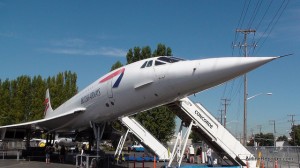
British Airways Concorde G-BOAG in the airpark
Off from the main floor is their Rendezvous in Space area and what a cool section. From a lunar rover to a full mock-up of a space station module that you can go inside of. The module is very interesting because there is no obvious “up.” Since there is no gravity, there is no floor and the signage for the buttons reads in different directions.
The way they have the area set up, it really puts you in a space-like setting, which makes the experience all that much more enjoyable. The museum is currently working to bring one of the space shuttles to their facility. You can sign a petition or donate to help their efforts and help Seattle get a Space Shuttle — and what city wouldn’t want to get a Space Shuttle?
After checking out Rendezvous in Space, it was off to the Personal Courage Wing that looks at the history of World War I and II. This is a new addition to the museum with two stories of history. They not only display amazing aircraft from both wars, but also share much more history about the time period and really put the aircraft into perspective. Even if you don’t like airplanes, but enjoy history, you will love this section of the museum (double bonus if you like both).
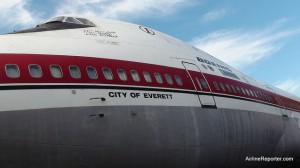
You are able to walk around the first ever Boeing 747, the City of Everett
My guide, Ted, told me that people always ask why World War II aircraft are downstairs (where you enter) and WWI are upstairs. He explained that it was all about weight. The aircraft from the earlier time period were much lighter than those from WWII, having it make more sense to store the lighter aircraft upstairs.
Now, it was time to head outside to their airpark to check out some pretty sweet airliners. First we went inside British Airways Concorde (G-BOAG). This was my first time inside a Concorde and it looked brand new still. The windows were super small and it was a little cramped, but not as bad as I expected. You are able to see in the cockpit and the few hundred fuses they have on the wall.
Having one of the remaining super-sonic airliners that is in such great shape is pretty exciting. Upon exiting, it was time to check out old Air Force One 707-120 that replaced Eisenhower’s Super Constellation. Ted explained that flight engineers, who used to work on the plane, recently came for a visit and they said the plane smells exactly the same as it did back in the day. Now, that is preserving history!
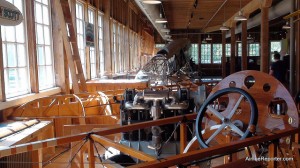
Inside the Boeing Red Barn at the Museum of Flight
Even though the Concorde and Boeing 707 are in pristine condition and you can go inside, the jewel of the airpark (in my opinion) is the first Boeing 747 (N7470). It is named the City of Everett after where it was built at Paine Field, located in Everett, WA. It first flew on February 9, 1969 and later served as a testbed for 747 systems improvements and new engine developments for other Boeing commercial jets, including the Boeing 777 engine program. She is not in the best shape, but that is something the Museum of Flight hopes to work on.
If you are into researching about planes, the MoF also has a public archive and library that you are able to visit. If you are in the Seattle area on October 9th or 10th, make your way to the Library and Archives Building, because they will be having a sale of a bunch of old aviation related books and other goodies.
There is so much more to explore at the MoF, an aviation nut could easily spend a few days there. For those of you who are local, it might be time to re-discover the Museum of Flight. For those of you that don’t live in the Seattle area, make sure to put this on your “must do” list and if you love aviation, you have to make it out to Seattle sometime to check out all the cool things we have to offer.
MORE PLEASE:
* 91 Photos I took during my trip
* Video with Harrison Ford (he loves aviation) promoting the Museum of Flight
* They have a vast collection of airline logos
* Friend the Museum of Flight on Facebook
* Follow them on Twitter
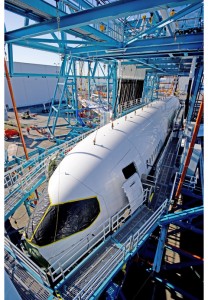
Boeing 787 Dreamliner undergoes fatigue testing at Paine Field. Photo from Boeing
The Boeing 787 Dreamliner has started it’s fatigue testing. The fatigue test frame might look like a crazy construction rig, but think of it more like a time machine.
The fatigue rig will put the Boeing 787 through 100,000 simulated flights, which is equivalent to about three times an expect life of the Dreamliner. The best part? It never has to leave the ground.
The fatigue test rig simulates every part of the flight. From the push back at the airport to the arrival at its destination. This process is called a ground-air-ground (GAG) cycle. Boeing has five different GAG cycles that put the aircraft through different simulations, ranging in duration and flight severity.
While the structural test program already has validated the strength of the airframe, fatigue testing looks at long-term, continued use. It allows Boeing engineers to see what will give over time and create inspection techniques for airlines.
“Every kid’s dream is to build something and then try to break it, right?,” asks Peter Brownlow, the fatigue testing conductor for the 787 program. “In essence, that’s what we’re doing. We take an airplane and we try to put it through its paces and try to break it at the end.”
To create this havoc, 100 mechanical devices have been connected to the exterior of the Dreamliner. Engineers in a control room use the devices to mimic actions the 787 will go through.
Boeing told me that they expect the fatigue testing to take about three years. Not bad. Too bad someone can’t earn any frequent flier miles for all those flights!
Also Check Out:
* Randy’s Journal with additional photos
* Awesome video from Boeing on the 787 fatigue test
* Photos of the test Boeing 787 coming out of the hangars in January
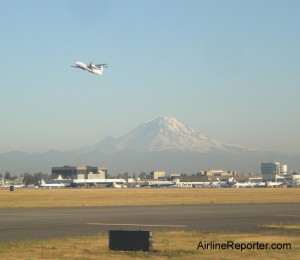
Why would you expect delays with nice weather like this seen in Seattle over the summer? Let's wait until winter DOT!
The Department of Transportation (DOT) is working with some funny math and concluding that the tarmac delay rule is working. Both Aubrey Cohen with the Seattle PI and Brett Snyder with CrankyFlier.com take a closer look at their math and don’t come to the same conclusions.
Instead of re-inventing the wheel, please read:
* DOT’s report, ’œLong Tarmac Delays in July Down Dramatically from Last Year’ that claims delays are down and cancellations have just a, “slight increase.”
* Snyder’s post, “DOT Continues to Claim Tarmac Delay Victory Despite 20 Percent Rise in Cancellations,” which shows how he doesn’t think a 20% increase in canceled flights is considered “slight.”
* Cohen’s article, “Cancellations inch up, or surge, thanks to tarmac rule,” takes a look how it might be a 20% rise, but when dealing with such small numbers, is it a big increase?
After taking a look at all three, I am not even close to admitting defeat (I am against the tarmac delay rule). It just started April 29th of this year and has only seen the summer. I am waiting to see what happens over the winter. Yes, I imagine delays will be down, but cancellations will be up — quite a bit. If I am wrong, I will more than happy eat my words, but I have a feeling there will be a lot of angry passengers this winter season.









